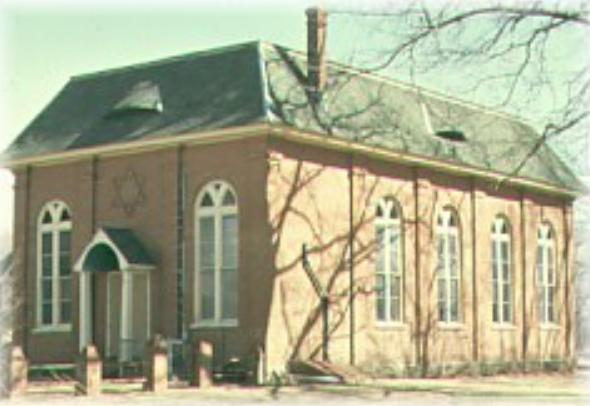 |
|
| Contents | |
| Farming Communities of NJ Homepage |
|
| Alliance,
Norma & Brotmanville |
|
| Woodbine | |
| Rosenhayn and Carmel | |
| Roosevelt |
|
| Farmingdale | |
| After World War II | |
| Synagogues
of Other Farming Communities |
|
| In the News | |
| Resources | |
| Memories | |
| Photos | |
| JewishGen
Home Page |
|
| KehilaLinks Home Page |
|
|
| Rosenhayn
is situated in Cumberland county, on the New
Jersey Southern Railroad. It was founded by the Hebrew Emigrant Aid Society of New York, 6 families having been sent to the northern part of Rosenhayn in 1883 as an outlet for population overflow from Alliance. Unlike Alliance, Rosenhayn did not receive continued support. These initial settlers shortly abandoned the colony. In 1887, other Jewish families bought land near Rosenhayn. In the following year, 37 additional families settled in the neighborhood. They were sold farm land on the condition that they should build houses and cultivate a certain part of their holdings within a specified time. This agreement imposed hardships on the colonists; for, in order to meet their payments, they had to work at tailoring, often as far away as Philadelphia or Camden. These settlers could not devote themselves to agriculture For some time they lived and toiled in a large wooden building opposite the Rosenhayn railway station. By the latter part of 1889 the Jewish settlers owned 1,912 acres at Rosenhayn, of which, however, only 261 acres were under cultivation—producing chiefly berries, corn, and grapes. There were 67 families, living in 23 houses, 6 of which were built by local Jewish carpenters. The population at that time amounted to 294, comprising 149 males and 145 females. Sixty of the children attended the public school. In this community there are 47 families, who derived a living wholly or in part from their farms, and who hold a total of 1,388 acres, of which 948 are under cultivation. Here, as at the other successful southern New Jersey Jewish colonies, there are factories, where a portion of the people earn most of their living expenses, thus furnishing a local market that pays a fair price for their products and enabling them to avoid the expensive freight rates and commissions attaching to the sale of produce elsewhere. Rosenhayn had a clothing factory and a brick yard, and manufactures to some extent tinware and hoisery. Jewish life in the community evolved around the synagogue and religious school.
Carmel, and lies in Cumberland county, in the southern part of the state, midway between Bridgeton and Millville, about three miles to the south of Rosenhayn. Seventeen Russo-Jewish farmers settled here in 1882. A year or two after the settlement, 7 of the original immigrants, discouraged by the poor results, left the colony, but their places were soon filled by others who came from western Russia. This second effort at colonization was supported initially by the Montefiore Agricultural Aid Society (MAAS). MAAS advocated the resources of the colony, such as farming equipment, be held communally. In 1889, the colony contained 286 persons, of whom 150 were men and boys and 136 women and girls, living in 30 houses. The farms comprised 864 acres, of which the Jewish colonists occupied 848 acres, although only 123 were under cultivation. Corn, rye, buck-wheat, vegetables, and berries were the chief crops. During the winter the farmers supported themselves by tailoring. In the latter part of 1889, owing to a gift of $5,000 by Baron Maurice de Hirsch, 1,500 additional acres of land were purchased, and 36 new houses erected. The condition of the colony at Carmel had been one of varying prosperity and depression. Outside aid, either by the establishment of local industries, by liberal loans on mortgage at a low rate of interest, or even by direct gifts, was necessary from time to time to enable the colony to exist. In 1900, Carmel contained, 89 Jewish families, whose members aggregated 471 persons. The number of families engaged exclusively in farming is 19; 14 combine farming and tailoring, 13 are engaged in farming, 23 in trades other than tailoring, and 33 earn their living exclusively by tailoring. These families owned 1,029 acres of land, of which 113 are devoted to fruit-growing, 504 to raising market produce, while the remaining land is devoted to pasture or fodder. Of the dwelling-houses, 46 were occupied, together with 86 barns and other outbuildings. In the community, several factories had been established mainly for the manufacture of clothing. These factories provided the employment that was the principal source of income for many settlers. Carmel had a clothing factory, and two others where ladies’ waists and wrappers are manufactured. Among these rural tailors of Carmel radicalism seemed to take hold. Some tried to deliver socialist lectures and roused factory workers to strike. A consumers' cooperative, a farmers' cooperative and producers (factory) cooperatives were quasi-radical experiments. The community was close knit with many participating in discussion groups, amateur concerts and operettas such as the Yiddish "Bar Kochba". On Simchat Torah, there were annual torchlight parades from the community hall to the synagogue. On July 4th, the festivities included a baseball game. |

